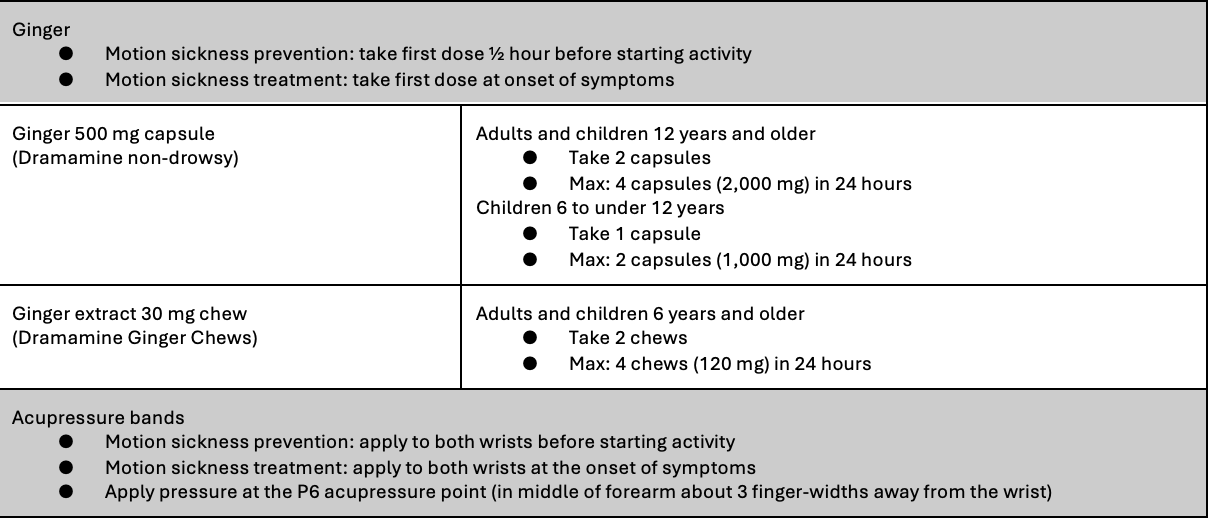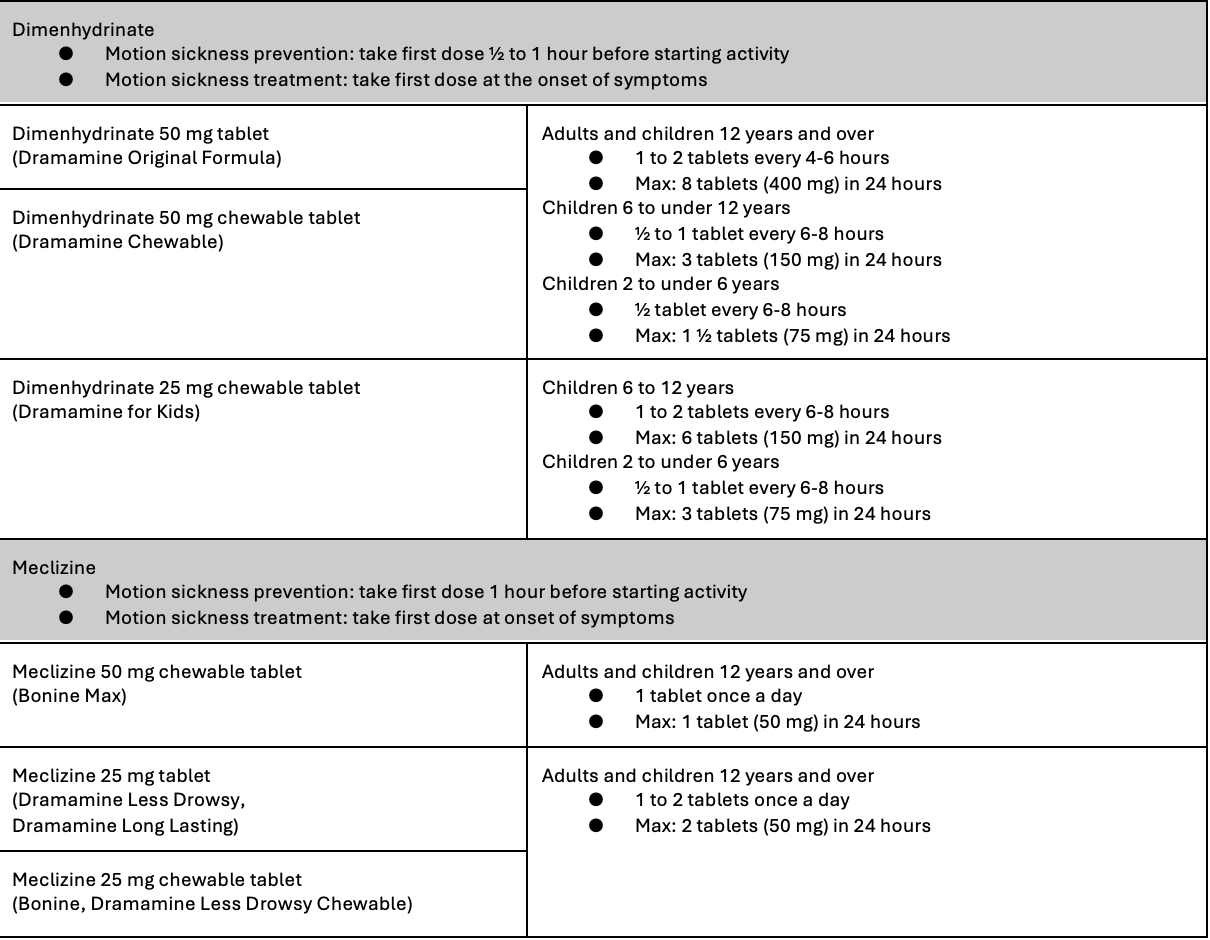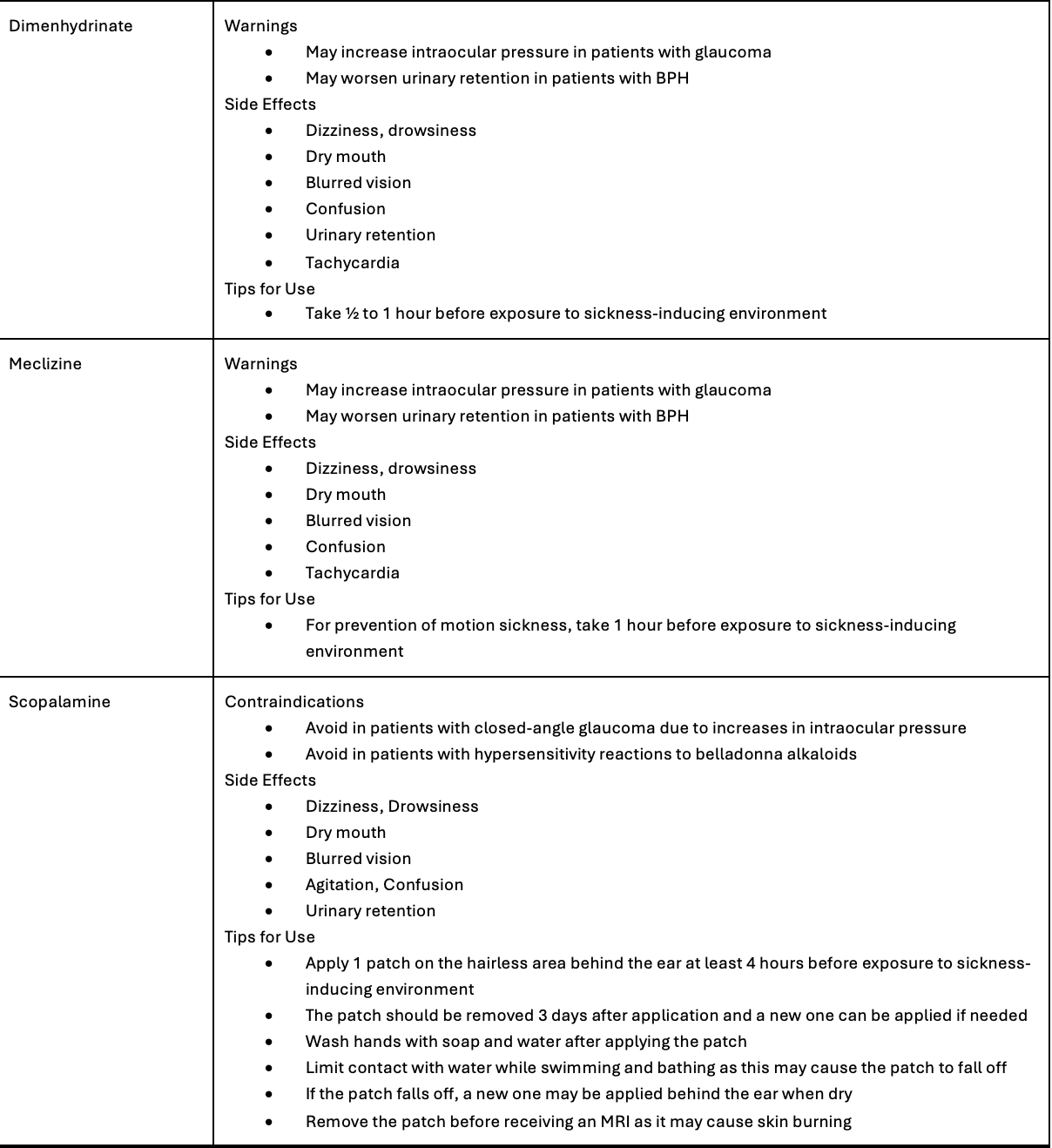Commentary
Article
Advise Patients About OTC Options for Treating Motion Sickness
Author(s):
Many cases of motion sickness can be managed safely with available OTC products.
INTRODUCTION
Motion sickness is a physiologic response that can occur when traveling by sea, air, car, train, or through virtual reality immersion. Anyone with a functioning vestibular system can develop motion sickness given sufficient stimulation, but certain individuals are more at risk than others. Common risk factors include age, sex, concurrent medical conditions, and multiple medications.1 Those between the ages of 2 and 12 years are at highest risk, with risk decreasing through adulthood. Incidence is also greater in females than males.1,2 Other risk factors include pregnancy or menstruation, hormone therapy replacement, oral contraceptives, and those with a history of migraines or vertigo.1
Image credit: Daniel Jędzura | stock.adobe.com

SYMPTOMS
Motion sickness can involve the gastrointestinal system as well as the central and autonomic nervous systems. The most common symptoms reported are nausea and dizziness, which can progress to vomiting if not treated. Other symptoms that may be specific to each patient include headache, hypersalivation, a general feeling of malaise, and hyperventilation. Physical signs are often not present, but some cases may include increased pallor and perspiration. Symptoms often decrease after 36 to 72 hours of continuous exposure to the causative environment but can occasionally return when exposure to this environment comes to an end.2
PATHOPHYSIOLOGY OF MOTION SICKNESS
Sensory Conflict Theory is the most widely known and accepted mechanism for motion sickness. This theory suggests that the condition is caused by conflict between the visual, vestibular, and somatosensory systems.1 The vestibular and somatosensory systems both have a role in maintaining balance and detecting spatial orientation, while the visual system is able to perceive orientation through a person’s field of vision.2
When engaging in self-generated movements such as walking or running, the motor command given by the brain aligns with the sensory feedback received from these 3 systems. This harmony between brain commands and sensory feedback does not often result in motion sickness because the brain accurately predicts the head's orientation and movement. When engaging in passive movements not generated by the brain, such as riding in a car or boat, the brain is reliant on the visual, vestibular, and somatosensory systems to determine the course of motion. If any of these systems receive inputs that contradict one another, motion sickness may occur. For instance, a passenger on a boat who is sitting below deck may not have any visual signs of motion, but the vestibular system senses the boat rocking back and forth. The discrepancies between these 2 inputs can ultimately cause motion sickness.2
Although the exact anatomical pathway for motion sickness is not well understood, there are several neurotransmitters that appear to be involved in this process, including acetylcholine (ACh), histamine (H), and norepinephrine, as well as some involvement from the Gamma-aminobutyric acid (GABA) receptors.1
TREATMENT OF MOTION SICKNESS
Determining Eligibility for OTC Treatment
Many cases of motion sickness can be managed safely with available OTC products. However, patients should be referred to visit a health care provider in any of the following scenarios:2
- Motion sickness occurring in a child less than 2 years of age
- Feelings of nausea, dizziness, or prolonged vomiting that do not decrease or subside within a day of removal from the sickness-inducing environment
- Nausea and dizziness accompanied by a migraine-type headache
- Motion sickness that does not subside despite appropriate use of available OTC treatments
Lifestyle Modifications
Treatment of motion sickness can sometimes be ineffective. For this reason, there may be an emphasis on preventing motion sickness. All patients should be counseled on environmental modification. This can include focusing on the horizon or other stationary objects, avoiding reading or looking at screens while in motion, selecting the seat with the least motion (e.g. the front seat of a car), and driving a car instead of being the passenger.2
Complementary and Alternative Therapies
Complementary and alternative therapies should also be offered to patients. This includes ginger and acupressure bands.2 See Table 12-4 below for details on available treatment options.
Table 1.2-4 Complementary and Alternative Therapies for Motion Sickness

Drug Therapies
H-1 and ACh receptors are involved in the vestibular pathways that produce motion sickness. Therefore, blocking these pathways with antihistamines and anticholinergic medications can help prevent symptoms from occurring. First generation antihistamines such as dimenhydrinate and meclizine are effective options because they are antagonists of both the H1 and ACh receptors. The benefits and risks of these medications must be weighed, however, because antagonism of the ACh receptors produce drowsiness and sedation.5 Other adverse effects include blurred vision and dry mouth. When recommending either of these medications, patients should be informed that using other sedative medications concurrently can cause additional drowsiness. Additionally, alcohol should be avoided while taking these medications. Meclizine has been noted to be less sedating and is dosed once daily.6,7
Second generation antihistamines that do not cause drowsiness (e.g. cetirizine, loratadine, fexofenadine) do not have activity at the ACh receptors and are not effective in treating motion sickness.2,5
Directions to prevent and treat motion sickness for effective OTC medications are listed in Table 26-13 below.
Table 2.6-13 OTC Medications for Motion Sickness

Additional therapies are available to use in place of dimenhydrinate if the patient obtains a prescription, including the ACh receptor antagonist scopolamine. This medication is available in a patch form that lasts up to 72 hours. Adverse effects are similar to those of the first-generation antihistamines, including dry mouth, drowsiness, and blurred vision.2 If patients would prefer a patch to prevent motion sickness, they should be referred to their provider to discuss whether it is an appropriate option for them. Details on the scopolamine patch are listed in Table 314 below. Key counseling points to discuss with patients regarding all OTC and prescription drug treatments for motion sickness are included in Table 4.6,7,14
Table 3.14 Prescription Therapies for Motion Sickness

Table 4.6,7,14 Counseling Points for Motion Sickness Medications

RECOMMENDATIONS FOR SPECIFIC POPULATIONS
Children
Children aged 2 through 12 years are at an increased risk for developing motion sickness, and therefore it may be common to make OTC recommendations for this population.1 Each therapy has specific recommendations regarding appropriate age ranges for safe use. Specific medications recommended for use in each age range are as follows:3,6,7
- Children 2 to < 6 years: dimenhydrinate
- Children 6 to < 12 years: dimenhydrinate, ginger
- Children ≥12 years: dimenhydrinate, meclizine, ginger
Please refer to Table 26-13 for the recommended dosing for each age range. Pharmacists should recommend that patients speak to their physician before using any of the listed medications outside of these recommended ages.
For pediatric patients who are unable to swallow pills, dimenhydrinate and meclizine are both available as chewable tablets.9,13 Ginger capsules can also be opened and sprinkled into food or drink.3
Older Adults
Many medications used for motion sickness can cause drowsiness and increase the risk of falls in older adults. Both dimenhydrinate and meclizine may also put older adults at increased risk of confusion and urinary retention.2 If a patient appears to be at an increased risk of falls, it may be appropriate to recommend meclizine over dimenhydrinate because it causes less drowsiness.5 Ginger may also be an appropriate option to consider in this patient population because it does not cause drowsiness.3
Pregnant Individuals
Patients who are pregnant may be more susceptible to motion sickness. When supporting a patient during pregnancy, initial treatment is often conservative, including identifying and removing the trigger and considering the use of ginger. There are several products that can be safely used for nausea and vomiting often affiliated with morning sickness. Antihistamines, including meclizine and dimenhydrinate, can be considered. For other additional options or if the patient does not experience relief, patients should contact their physician.15
THERAPY FAILURE WITH OTC PRODUCTS
If patients report experiencing motion sickness despite using OTC products, including meclizine and dimenhydrinate, it may be appropriate to assess the patient’s understanding of the administration directions and ensure the medication is taken before exposure to the inducing environment. After adherence is verified, patients should be referred to their health care provider to discuss possible prescription medications. Scopolamine is the most commonly prescribed medication for motion sickness, but other options that have varying data from small trials include promethazine, diazepam, and rizatriptan. The antiemetic ondansetron has not been shown to be effective in preventing or treating motion sickness and should not be used for this indication.2
THE ROLE OF THE PHARMACIST
Pharmacists often serve as the first point of health care contact for patients, therefore requiring the skills necessary to collect information about the symptoms and determine whether the patient is a good candidate for self-care. For patients who are eligible for OTC treatments, pharmacists are able to make confident recommendations for products and patient monitoring. Although motion sickness is very common, the number of options can be overwhelming. With the help of pharmacists, patients have an opportunity to gain support from a skilled and trained health care provider.
References
Motion Sickness. CDC Yellow Book 2024. wwwnc.cdc.gov.
Priesol AJ. Motion Sickness. UpToDate. Updated June 23, 2023. Accessed February 27, 2024. www.uptodate.com.
Dramamine Non-Drowsy. Prestige Consumer Healthcare Inc. 2024. Accessed February 27, 2024. https://www.dramamine.com/
Dramamine Ginger Chews. Prestige Consumer Healthcare Inc. 2024. Accessed February 27, 2024. https://www.dramamine.com/
Karrim N, Magula N, Saman Y. Antihistamines for motion sickness. Cochrane Database of Systematic Reviews. 2022;10(10):CD012715. doi: 10.1002/14651858.CD012715.pub2
Dramamine Original Formula. Drug Label. Prestige Consumer Healthcare Inc; 2023. Accessed February 27, 2024. https://dailymed.nlm.nih.gov/
Dramamine Less Drowsy. Drug Label. Prestige Consumer Healthcare Inc; 2024. Accessed February 27, 2024. https://dailymed.nlm.nih.gov/
Dramamine Chewable. Drug Label. Prestige Consumer Healthcare Inc; 2024. Accessed February 27, 2024. https://dailymed.nlm.nih.gov/
Dramamine For Kids. Drug Label. Prestige Consumer Healthcare Inc; 2021. Accessed February 27, 2024. https://dailymed.nlm.nih.gov/
Bonine Max. Drug Label. Wellspring Pharmaceutical Corporation; 2022. Accessed February 27, 2024. https://dailymed.nlm.nih.gov/
Dramamine Long Lasting. Drug Label. Prestige Consumer Healthcare Inc; 2019. Accessed February 27, 2024. https://dailymed.nlm.nih.gov/
Bonine. Drug Label. Wellspring Pharmaceutical Corporation; 2021. Accessed February 27, 2024. https://dailymed.nlm.nih.gov/
Dramamine Less Drowsy Chewable. Drug Label. Prestige Consumer Healthcare Inc; 2019. Accessed February 27, 2024. https://dailymed.nlm.nih.gov/
Transderm Scōp (scopolamine) transdermal system patch. Prescribing information. Novartis; 2013. Accessed February 27, 2024.
Quinlan JD, Hill DA. Nausea and Vomiting of Pregnancy. American Family Physician. 2003;68(1):121-128. Accessed February 27, 2024. https://www.aafp.org/pubs/afp/issues/2003/0701/p121.html#:~:text=Meclizine%20(Antivert)%2C%20dimenhydrinate%20





